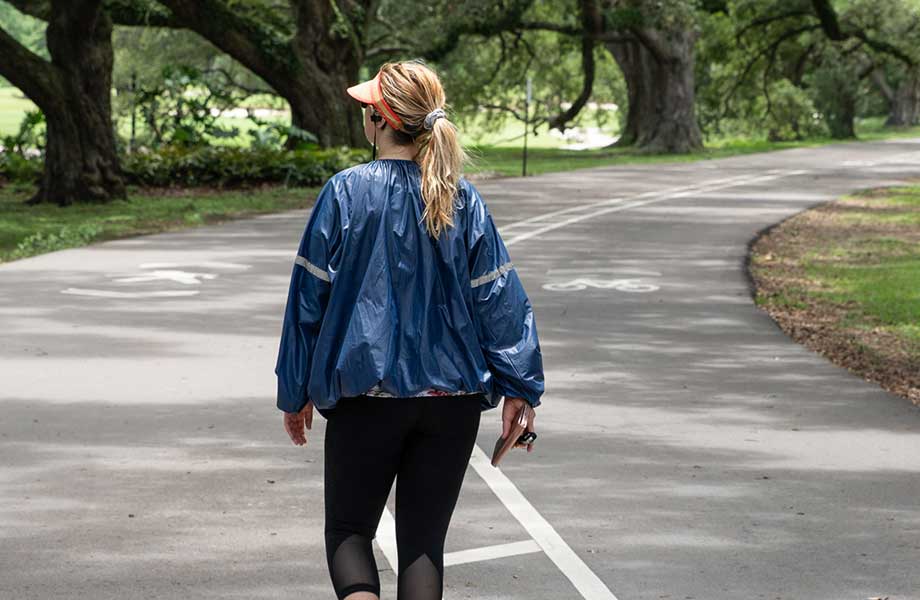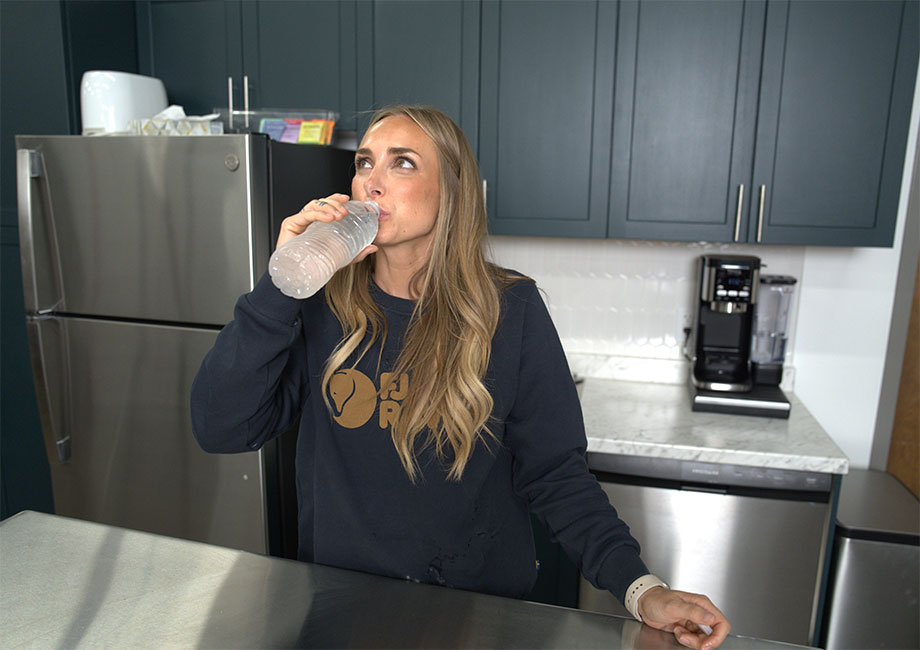We test and review fitness products based on an independent, multi-point methodology. If you use our links to purchase something, we may earn a commission. Read our disclosures.
The fitness industry is full of tips, tricks, and all-out gimmicks to increase calorie burn and improve health, and sauna suits fall into that category. Sauna suits get their name from the centuries-old Scandinavian tradition of wet and dry saunas, except sauna suits are designed for use while exercising versus chilling in a steamy room in your birthday suit.
RELATED: Dry Sauna Benefits
What is a sauna suit? It’s a souped-up heat holder that increases sweat output, calorie burn (though minimal), and heat acclimation. Sauna suits won’t win any fashion awards, but get the facts before you slip one on for your next cardio session. While those pros sound good, they come with dangerous risks that require extreme caution.
Read on to get the details of heating up your workouts and decide whether a sauna suit is in your fitness future.
What Is a Sauna Suit?
Sauna suits (aka sweat suits) vary in design, but all are clothing designed to retain heat. They’re typically made of non-breathable materials like neoprene, PVC, or nylon. Some suits look similar to a tracksuit with long sleeves and full-length pants for full-body coverage.

Others are separates with a sauna shirt with or without sleeves and pants you can wear together or separately. Sauna suits trap heat, which increases body temperature and perspiration.
MMA fighters, wrestlers, and weightlifters are classic examples of athletes who, in the past, have used sauna suits for added heat retention to lose water weight before competition. However, we would be remiss if we didn’t mention that the NCAA1, and some other athletic governing bodies, prohibit the use of sauna suits. The ruling came about in 2013 after three wrestlers’ deaths2 were linked to overheating and dehydration in connection with the use of sauna suits.
Are Sauna Suits Effective?
When used carefully, sauna suits can provide some health benefits. However, fair warning that there’s currently a very small body of studies exploring their use, and these suits should be used under extreme caution. The studies are limited and are typically done with a very small pool of participants. That being said, they can be effective for very specific purposes.
In a 2018 study3 that focused on the effects of wearing an upper-body sauna suit, researchers found the sauna suit increased the core body temperature and sweat volume compared to workouts of the same intensity.
What Are the Benefits of a Sauna Suit?
Cranking up your internal furnace offers health benefits and the potential to help you reach specific fitness and weight goals. Athletes might incorporate them to train for specific climate conditions or use sauna suit separates to keep warm in cold conditions. Someone with limited workout time might wear one to increase workout efficiency, while others might use it to increase energy use.
Heat Acclimation
Running, biking, or hiking in 90-degree weather puts a heavier load on your body than doing the same activity in a balmy 50 degrees. Both a 2017 study4 and a 2020 study5 published in the International Journal of Research in Exercise Physiology found evidence that exercising in a sauna suit can help acclimate the body to higher temperatures.
RELATED: Guide to Outdoor Training

If you’re training for an event that will take place in a climate that’s warmer than where you live, a sauna suit has the potential to help you prepare weeks in advance. Additionally, sauna suit tops or bottoms are an option if you’re training in cold conditions as a warming layer.
Improved VO2 Max and Ventilatory Threshold
The previously mentioned 2017 study also found that participants who trained for 14 days in a sauna suit showed improved VO2 max, ventilatory threshold, and time trial performance. VO2 max is your body’s oxygen uptake, and ventilatory threshold is the point at which oxygen delivery to the muscles begins to limit your ability to exercise. A sauna suit helps potentially improve athletic performance at a faster rate than exercising without one.
Bump Up Energy Output
The Journal of Strength and Condition Research6 published a study in 2022 showing that participants burned an additional 23 calories per hour when wearing a sauna suit. While that’s not a huge difference for weight loss, the study also found that fat oxidation increased for 60 minutes post exercise.
Fat oxidation is how your body breaks down and uses fat stores. This study was small, with only 12 participants, so the results are far from conclusive, but it hints toward a sauna suit’s potential for increased calorie burn and reduced body fat.
RELATED: How To Lose Body Fat
What Are the Risks of a Sauna Suit?
Sauna suits work against the body’s natural cooling system, which doesn’t come without risks. Too much body heat and excess sweating can lead to life-threatening conditions, so do not take wearing a sauna sweat suit lightly.
Hyperthermia (Overheating)
Sauna suits prevent the body from cooling itself, which can easily lead to hyperthermia, aka overheating. Overheating might not sound too bad, but it’s dangerous and can go from mild to severe very quickly. The intense heat can lead to heat exhaustion or heat stroke, where vital organs can begin to shut down.
Dehydration
Sauna suits increase perspiration, which basically means you sweat like a winter rain in Seattle. While it’s always a good idea to sip water while you exercise, with the excess water loss created by a sauna suit, it’s absolutely necessary.

You must also be highly attuned to the environmental temperature. Do not wear a sauna suit in extreme temperatures, as they can make it difficult to maintain hydration. Keep in mind that increased perspiration will also cause increased loss of electrolytes7, which you may need to replace more carefully when using a sauna suit.
Sauna Suit Safety and Precautions
Sauna suits can have their place in a fitness plan, though they need to be used carefully and under the right conditions. Talk to a medical professional before you start wearing this type of clothing. People with medical conditions that make it difficult to regulate body temperature should probably not wear this type of suit.
Additionally, do not use a sauna suit in hot workout conditions or weather. The heat strain can overpower your body quickly. Always keep water nearby, and sip on it regularly to make up for the water lost through excess sweating. You may also need to drink liquids with electrolytes to replace those lost through increased perspiration.
RELATED: Best Electrolyte Drink
What Is a Sauna Suit? Final Thoughts
Sauna suits have the potential to help with heat acclimation, VO2 max, fat oxidation, and oxygen use. However, use these suits with caution. Much of their weight-loss claims come from short-term loss of water weight, and they can easily lead to dehydration and overheating. Keep these tips in mind:
- Sauna suits may help with heat acclimation.
- Sauna suit use has the potential to improve your VO2 max faster than exercising without a sauna suit.
- Sauna suits can lead to dehydration or overheating, especially if used in warm conditions.
- Talk to a medical professional before using a sauna suit to prevent aggravating any underlying medical conditions.
What Is a Sauna Suit? FAQs
Will sauna suits help lose belly fat?
Sauna suits might help with fat oxidation and overall calorie burn. However, you can’t spot-burn fat, you can only burn overall fat. Over time, as you burn more fat than you accumulate, you can reduce belly fat while reducing your overall body fat.
Should I work out in a sauna suit?
There’s a small body of evidence that suggests wearing a sauna suit can increase calorie burn, VO2 max, and fat oxidation. They can also be used to help you acclimate to hot conditions. However, you have to keep a close eye on your body temperature and hydration.
How long is it safe to wear a sauna suit?
Sauna suits are really only effective if you’re working out. You won’t see any benefits outside of your workout time. Give yourself time to get used to wearing a sauna suit—10 to 15 minutes might be plenty at first. Over time, you can add 5 minutes until you’re at around 30 minutes. Some athletes get used to wearing a sauna suit for up to 60 minutes, but that’s not recommended for most people. Keep water nearby and make sure you don’t get dehydrated.
Do you wear clothes under a sauna suit?
Some people like to wear clothing under a sauna suit to help absorb perspiration. The extra layer of clothing can also prevent skin irritation. However, an additional layer of clothing will further trap heat, so you need to be hyper-aware of hydration and how you’re feeling to make sure you don’t overheat.
References
- NCAA memorandum. (2023). https://ncaaorg.s3.amazonaws.com/championships/sports/wrestling/rules/2023-24PRMWR_WeightManagementProgramPacket.pdf
- NCAA media center. (2013). Wrestling away from a troubled past. Accessed June 24, 2024. https://www.ncaa.org/news/2013/10/9/wrestling-away-from-a-troubled-past.aspx
- Wilmott, A.G.B, et al. (2018). Physiological and perceptual response to exercising in restrictive heat loss attire with use of an upper-body sauna suit in temperature and hot conditions. Temperature. 5(2): 162-174. https://doi.org/10.1080/23328940.2018.1426949
- Van de Velde, S.S., et al. (2017). The performance benefits of training with a sauna suit: A randomized, controlled trial. International Journal of Research in Exercise Physiology. 13(1): 1-11. https://ijrep.org/wp-content/uploads/lana-downloads/2018/02/vandevelde.et_.al_.fall_.2017.pdf
- Carrillo, S.N., et al. (2020). Quantifying heat stress of sauna suits during physical activity and examining the effects of heat acclimation on physiological responses in hypoxic conditions: a preliminary explorative study on cross-adaptation. International Journal of Research in Exercise Physiology. 15(2): 35-52.
- Matthews, A.R.D., et al. (2022). Acute effects of high-intensity interval exercise while wearing a sauna suit on energy expenditure and excess post-exercise oxygen consumption. The Journal of Strength and Conditioning Research. 36(9): 2427-2433. doi: 10.1519/JSC.0000000000003834
- Baker, L.B., et al. (2019). Exercise intensity effects on total sweat electrolyte losses and regional vs. whole-body sweat [Na+], [Cl−], and [K+]. European Journal of Applied Physiology. 119: 361-375. https://doi.org/10.1007/s00421-018-4048-z
Further reading

If you’re debating using a treadmill vs recumbent bike, we have some key considerations for you. Read more

This lifting belt provides support at a competitive price. See all of its pros and cons in our Gymreapers Quick-Locking Weightlifting Belt review. Read more

Explore the pros and cons of various types of diets, from Keto to Paleo, to find the best weight-loss plan that suits your needs and preferences. Read more

Our Sunny Health and Fitness exercise bike reviews takes a look at three of the company’s best bikes and let’s you know which is best for you. Read more

